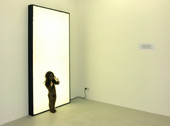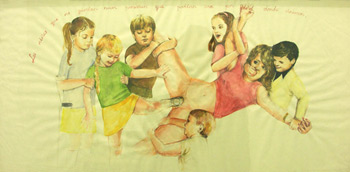DESTINY’S CHILD
Masha Godovannaya, Antonio de la Rosa, Csaba Uglár
09. okt. – 10. nov.
The target of the show is to appoint "an other aspect" on the childhood, to reveal in a kind of psychedelic way to the facts behind the curtain, to the withholded things - cause "the child is father to the man".
Masha Godovannaya
December 2006
Artistic Statement
Reality, life itself, forms the essence of my creative process. Rather than try to impose control over reality, I follow its lead, letting it guide me along the roads of life.
Although my films always have a conceptual starting point, I rarely work from a script. Being in the right place at the right time, with appropriate equipment, is of primary importance for me. I trust my intuition to find the material which, later on, will become a finished film. I keep an open mind while filming, allowing the subject matter to determine the form and rhythm of the film.
My films take shape in the editing room, where I pare away at the footage until only the essentials remains. The sound-track is conceived once the film is nearing completion, adding another layer of meaning, complementing the mood of the image.
Children playing on the street in Brooklyn, drunks at the Mars bar in the East Village, a visit to a Russian monastery, a ride on the Staten Island ferry, the alternation of light and darkness in the subway, a young flamenco dancer on a St. Petersburg street ... my films reveal the poetry of these ordinary acts of life.
Richard Leacock explained his approach to filmmaking by quoting Leo Tolstoy, who envisioned the film-maker "as an observer, perhaps a participant, capturing the essence of what takes place around him; selecting, arranging but never controlling." Leacock himself rejected the overpowering role of the filmmaker in contemporary cinema. He was convinced that "the significance of what is taking place could quite conceivably transcend the conception of the film-maker, being essentially the mystery of reality. Many film-makers feel that their goal is to be in complete control. The conception of what happens is thus limited to the conception of the individual film-maker. We don’t limit reality to this extent. What happens in front of us - the action - has no limitations, no more than does its significance. The film-maker’s problem is one of representation: how to convey the feeling of being there."
One of my most recent films “Another Place And Yet The Same” (2005) takes a new approach to the representation of reality and time. The film portrays a natural world with its own set of temporal, spatial and rhythmic connections. This new world does not comply with the accepted logic of phenomenological evolution. My intention was to provoke a sensation of recurrence; the cyclical self-renewal of a nature over which we humans have no control - but for which, nonetheless, we must assume responsibility. Slower in tempo, this film nonetheless shares the inner rhythm, visual style and conceptual basis of my previous works. I'm more interested in reality - "that ultimate mystery" - than in any logical sequence of staged events from which the true fibre of life is sadly missing. As the filmmaker Ron Rice observed, "any fragment of real life - no matter which - can provoke more of man to believe and feel than any parallelism of reality-deprived logic. It is better to film anything at all that is living and real than to film ideas of what should, or might be, real."
“Another Place And Yet The Same” is my first investigation into the plastic qualities of film per se. I used a wide range of 16mm film stock to shoot the film: color, black and white, reversal and negative. Out-of-date stock produced unusual color combinations and tonal values. The majority of the film was hand-developed in Lake Seliger itself, embedding dust, grass, scratches, and plankton directly into the emulsion. A wide range of stocks, with different speeds and color temperatures, combined with a variety of camera filters, stretched the limits of the film medium. Overexposure, underexposure, grain, dirt and wildly unpredictable color: these 'flaws' which would, no doubt, condemn the footage irremediably in the eyes of the 'professionals' are to me essential qualities, both with regard to this film in particular and to my cinematic approach in general.
My most recently completed work, "Gnawed Vanity” (2006), consists of a parallel investigation into the plastic qualities of video as a medium. I am particularly interested in the processes of video capture and image creation, so different from those of film. In my videos, I transform the so-called 'problems' inherent in video technology (artifacts, distortions) into creative and unique expressions of the format and its limitations: a song of praise for the analog video format.
Using the above conceptual precepts as a starting point, I intend to continue my research into the film and video media, with an eye to the broader field of the visual arts in general. I consider film and video to be parts of a single whole; not isolated media but intrinsic elements of the ever-expanding and organic world of artistic creation.
Antonio de la Rosa
" Die Kinder, die nicht geboren werden wollten dachten, dass sie dahin zurückkehren könnten woher sie gekommen sind"
" children that didn´t want to born thought they could go back through the same way they came from"
Csaba Uglar / Hiry Girl / installation
Nach der Niederschlagung des ungarischen Freiheitskampfes von 1848/49 erwarb Julius von Haynau , der europaweit unter dem Namen des Hyäne von Brescia bekannt geworden war, ein Anwesen in einem abgelegenen Dorf in Ungarn, in Nagygéc.
Hier kam seine Tochter zur Welt, die an einer seltenen , genetisch bedingten Krankheit leiden sollte.
Das Kind war, einem Tier gleich, von Geburt an von Kopf bis Fuß behaart. Die Familie des Generals versuchte, die Existenz des Mädchens geheim zu halten, trotzdem wurde in der Ortschaft bekannt, daß die Tochter des verhassten Henkers, der 1848 die ungarischen Generäle zu Tode verurteilt hatte, als Ungeheuer zur Welt gekommen war. Die Familie gibt nach drei Jahren den Besitz auf.
Das Anwesen erwirbt danach die Familie Groszmann. Jahre später wird auch ihnen eine behaarte Tochter geboren. Auch die Groszmann Familie verlässt den verfluchten Besitz.
Jahrzehnte später zerstören die Bewohner des Ortes das Schloss und verwenden die Steine des verlassenen Anwesens für ihre Häuser. So zogen sie einen Fluch auf sich und wurden Teil einer Ballade. Nach Szendrö Ivan , der diese wundersame Geschichte entdeckt, zusammengetragen und durchlebt hat, wird auch derjenige Teil der Geschichte, der diese weitergibt.
Im Jahre 1970, als ich geboren wurde, vertilgte die Flut des Szamos die Ortschaft Nagygéc endgültig von der Landkarte.
Es ist nur ein Zufallsprodukt , das diese Ausstellung am 6. Oktober, dem Tag der Märtyrer (Zeugen) von Arad eröffnet wird.





